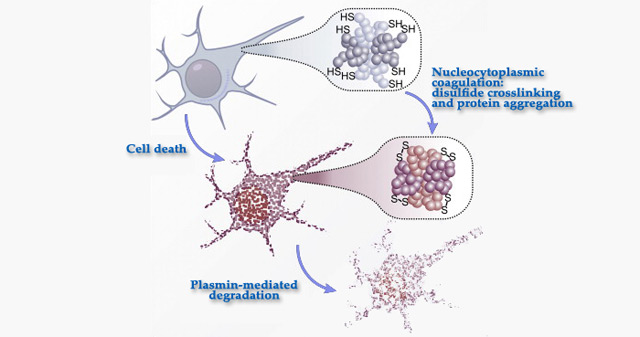Australian scientists have shown that an enzyme called tissue-type plasminogen activator (t-PA), which plays a vital role in the removal of blood clots, is also a major player in the removal of necrotic cells.

This drawing shows how an injured cell undergoes a restructure to prepare for efficient removal from the body (Andre L. Samson et al / Cell Reports)
Necrosis occurs when cells in living tissue die prematurely due to injury or external stress. The body’s system for removing waste associated with necrotic cell removal was not well understood, until now.
The researchers found that in the late stages of death, the injured cell undergoes a restructure and takes on a form not unlike a blood clot, to prepare for efficient removal from the body. This process, called the nucleocytoplasmic coagulation (NCC), had never been described before.
“The blood clot-like structure allowed the damaged cells to be recognized and removed by t-PA and its enzymatic waste disposal team,” said Prof Robert Medcalf of the Monash University’s Australian Center for Blood Diseases, senior author of the study published in the journal Cell Reports.
“It’s exactly the same principle as the formation and removal of a blood clot. In the process of a cell dying it goes through this unique form of aggregation to keep all the intracellular debris localized. Then, it can be taken out in an orderly fashion by the blood clot-busting enzyme system without causing damage to the body.”
The researchers were studying brain tissue when they made the discovery, but have shown that the same process applies to every cell in the body.
“It’s very efficient. Instead of doubling up, the body is using the same disposal system to eliminate a variety of unwanted waste products, be they dead cells or blood clots that have served their purpose,” Prof Medcalf said. “What this means is that t-PA and its team of enzymes recognizes waste through structure or shape, not by the specific proteins involved.”
The results shed light on the function and therapeutic uses of t-PA, which is used in the treatment of stroke and heart attack.
_______
Bibliographic information: Andre L. Samson et al. Nucleocytoplasmic Coagulation: An Injury-Induced Aggregation Event that Disulfide Crosslinks Proteins and Facilitates Their Removal by Plasmin. Cell Reports, 04 October 2012; doi: 10.1016/j.celrep.2012.08.026







